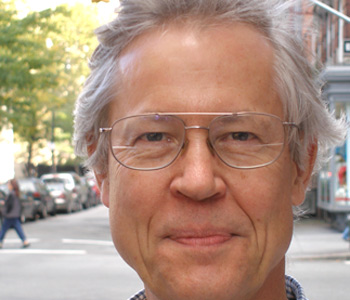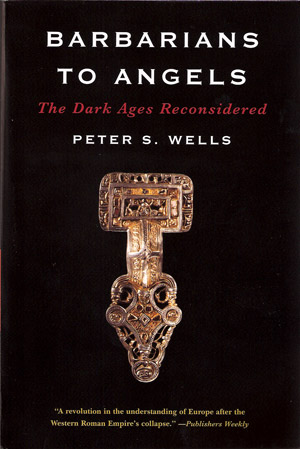
My book is about the peoples who are often referred to as “barbarians” during the period commonly known as “the Dark Ages.” I argue that far from being the uncivilized and unaccomplished peoples whom many Late Roman writers described, the communities of the early Middle Ages achieved great heights in artistic creativity, technology, manufacturing, and commerce.
The special approach of Barbarians to Angels is to use the archaeological evidence of these peoples, rather than trying to understand them by taking at face value the assertions of Roman writers. The Romans were not part of these societies. So I use the direct evidence of material culture to understand how people of early medieval Europe fashioned their social, economic, and religious worlds.
“Archaeology shows us that even small communities during the so-called Dark Ages belonged to complex and extensive networks through which goods, technology, and ideas flowed.”
I have always been interested in applying the techniques of archaeology to understand peoples who were described by others but who left no written record themselves. Julius Caesar’s descriptions of the people the Romans called “Gauls” is one prime example, Tacitus’s accounts of the “Germans” is another. My training in anthropology helps me to understand societies on their own terms, rather than interpreting them through the eyes of others. The rich archaeological evidence from Late Roman and early medieval Europe makes such an approach possible.
That evidence enables us to look in detail at how people in the period AD 400-800 built their houses and organized their settlements; how they fashioned their tools, weapons, and personal ornaments; how they practiced religious rituals; and how they expressed status relationships in their social systems through funerary ritual.
Archaeological study of workshops indicates both the kinds of crafts that people practiced and the scale of production. Study of imported objects shows us that, contrary to the image some people have of small, isolated communities during the Dark Ages, communities of that time had access to goods not only from all over Europe, but from Africa and Asia as well.
My approach in this book is informed to a large extent by my experience conducting fieldwork—archaeological excavations—on settlements in late prehistoric Europe. One of the sites at which I have excavated, at Kelheim on the Danube River in Bavaria, Germany, was the location of a substantial town at the time that Julius Caesar was campaigning in what is now France in the course of his conquest of Gaul (middle of the last century BC).
The experience of excavating and recovering the direct physical remains of the daily activities of people who lived 2000 years ago gives one a deep appreciation for the ways that material culture links past and present. For example, we recovered charred grain from the meals people prepared, pottery out of which they ate their meals, iron tools that they used to build their houses, and debris from the smelting of ore to make the iron with which they fashioned those tools. Materials such as decorated fine ceramics, figural images on the coins they minted, and brightly colorful glass bracelets and beads allow us to see not only the economic aspects of their daily lives, but also the ways in which they expressed their aesthetic sensibilities. Working directly with such objects provides a feeling for how material culture relates to peoples’ lives and values, both in the past and in the present.
A browsing reader might find the chapters on craft production and trade most revealing. The archaeology shows us that even small communities during the so-called Dark Ages belonged to complex and extensive networks through which goods, technology, and ideas flowed. Craft products ranged from everyday utilitarian items such as the pottery that people used to prepare and eat their meals, to spectacular brooches and belt buckles of silver and gold, with inlay of brilliant red garnet.
The archaeological evidence enables us to identify the places where such things were made, the locations from which the raw materials were obtained, and to say how widely such products were distributed in society. Small trade centers all over Europe were actively engaged in both local and long-distance commerce. For example, the wind-swept cliffs of Tintagel on the coast of Cornwall was the site of a commercial center that imported large quantities of fine pottery from northern Africa. The island of Helgö near Stockholm in Sweden was home to a trade center that acquired goods from as far off as India.
These are just a few examples of the surprises that await us in examining the archaeological evidence from this period in Europe’s early history.
“The island of Helgo near Stockholm in Sweden was home to a trade center that acquired goods from as far off as India.”
My intention in writing this book was to show an interested reading audience that our ideas about the human past are often very different from what was actually going on at that time.
Until recently, people tended to readily accept written texts as reliable information about the past, even when they were written by members of different societies from those that they were describing. The so-called Dark Ages are a particularly good example, because at least since the publication of Edward Gibbon’s Decline and Fall of the Roman Empire, peoples of this period, including those whom we know by names such as Alamanni, Franks, Goths, Huns, and Saxons, have regularly been considered “barbarians.”
By looking closely at what those peoples were actually doing, and not just at what Late Roman commentators said about them, we get a very different picture.


Peter S. Wells is Professor of Anthropology at the University of Minnesota. Besides the book featured in this Rorotoko interview, his publications include The Barbarians Speak: How the Conquered Peoples Shaped Roman Europe (Princeton University Press, 1999), Beyond Celts, Germans, and Scythians: Archaeology and Identity in Iron Age Europe (Duckworth, 2001), The Battle that Stopped Rome: Emperor Augustus, Arminius, and the Slaughter of the Legions in the Teutoburg Forest (W.W. Norton, 2003).